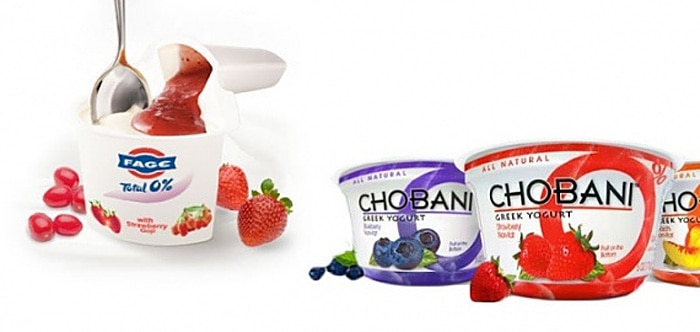
Written By: Owennie Lee, RD
Title: Registered Dietitian
Alumni: University of British Columbia
Last Updated on:

Greek yogurt, or strained yogurt, has been part of Mediterranean cooking for many years, yet it wasn’t until recent years that its popularity started to take off in North America. These days, Greek yogurt is a big presence on the yogurt scene and is continuing to gain raves and endorsements from just about everyone. Is Greek yogurt superior to regular yogurt, and are all Greek yogurts the same?

Table of Contents
Greek yogurt is made when yogurt is strained (sometimes more than once) with a cloth or paper bag or a filter to remove more whey, resulting in a product that has a thicker consistency. Some yogurt makers might boil off excess water, and others might add cream or milk powder to the milk to further enrich the yogurt. “Greek-style” yogurt, however, is thickened with thickening agents and may or may not be strained.
One of the reasons Greek yogurt has gained a following is that its non-fat version offers a great way to pack in almost twice as much protein as regular non-fat yogurt, yet without sacrificing the creamy smooth texture that regular whole yogurt offers.
| Per 6 oz. serving | Greek Non-Fat
Plain Yogurt |
Regular Non-Fat
Plain Yogurt |
Regular Whole
Plain Yogurt |
| Calories (kcal) | 100 | 95 | 104 |
| Fat (grams) | 0 | 0.3 | 5.6 |
| Protein (grams) | 18 | 9.7 | 5.9 |
| Carbohydrates (grams) | 7 | 13 | 8 |
| Calcium (mg) | 200 | 339 | 206 |
Greek yogurt can definitely be a healthy choice, but like all other packaged foods, you must read your nutrition labels. A survey of the most well-known brands of Greek yogurts reveals that almost all non-fat plain Greek yogurts are great choices. The simple ingredient lists contain nothing more than non-fat milk and bacterial cultures. It is when you steer outside of this category that things start to get iffy. For instance, some low-fat (2%) or whole Greek yogurts contain cream in addition to non-fat milk, resulting in yogurts that are more similar to ice cream in fat content than yogurts. (Regular whole yogurt has 5.6 grams of fat.) For example, Fage’s Total Classic Plain Yogurt delivers a whopping 20 grams of fat in a mere 7 oz. serving!
The other category that can spell trouble is the fruit-flavored Greek yogurts. Whether organic or not, they all contain some kind of thickener, plus flavor and coloring, and many contain very little real fruit, if any. For example, the word “strawberries” is nowhere to be seen on the ingredients list of Greek Gods’ “Honey Strawberry” yogurt. In lieu of real strawberries, the makers of Greek Gods merely added pectin and natural flavor. With fruit-flavored Greek yogurts, you are also trading more sugar for less protein and calcium.
Non-fat plain Greek yogurt is definitely the way to go when it comes to Greek yogurts. Unfortunately, none of them are fortified with Vitamin D (yet), but you can still enjoy the low-fat protein they pack together with the thick creamy texture that is unique to Greek yogurts. It is better to stay away from the sweetened or fruit-flavored varieties and add your own fresh or frozen fruits instead. Be sure to read the label and watch out for those with added cream, as you probably don’t need a big fat Greek yogurt!
Alumni: University of British Columbia – Owennie is a registered dietitian with a soft spot for chocolate and coffee. She is a believer in balance and moderation, and is committed to keeping healthy eating enjoyable and fun. Owennie received her dietetics training in Vancouver, and is a member of Dietitians of Canada and the College of Dietitians of British Columbia. She has experience in a wide variety of settings, such as clinical nutrition, long-term care and outpatient counseling. Owennie has also worked for a community nutrition hotline and participated regularly as a guest radio host, where she enjoyed sharing her passion and knowledge about food and nutrition with people.